Related Research Articles
Baseball statistics play an important role in evaluating the progress of a player or team.

In sports analytics, sabermetrics is the empirical analysis of baseball, especially baseball statistics that measure in-game activity. Sabermetricians collect and summarize the relevant data from this in-game activity to answer specific questions. The term is derived from the acronym SABR, which stands for the Society for American Baseball Research, founded in 1971. The term "sabermetrics" was coined by Bill James, who is one of its pioneers and is often considered its most prominent advocate and public face.
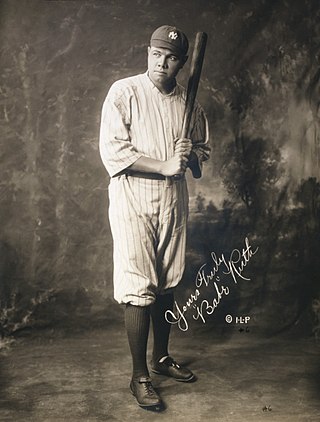
In baseball statistics, slugging percentage (SLG) is a measure of the batting productivity of a hitter. It is calculated as total bases divided by at-bats, through the following formula, where AB is the number of at-bats for a given player, and 1B, 2B, 3B, and HR are the number of singles, doubles, triples, and home runs, respectively:

James Edward Rice is an American former professional baseball left fielder and designated hitter who played in Major League Baseball (MLB). Rice played his entire 16-year MLB career for the Boston Red Sox. He was inducted into the Baseball Hall of Fame in 2009.
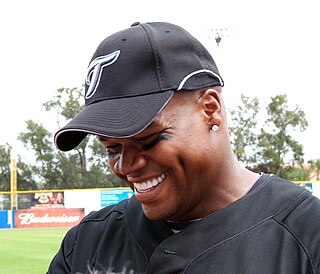
Frank Edward Thomas Jr., nicknamed "the Big Hurt", is an American former professional baseball first baseman and designated hitter in Major League Baseball (MLB). He played for three American League (AL) teams from 1990 to 2008, all but the last three years with the Chicago White Sox. A five-time All-Star, he is the only player in major league history to have seven consecutive seasons (1991–1997) with at least a .300 batting average, 100 runs batted in (RBI), 100 runs scored, 100 walks, and 20 home runs. Thomas also won the AL batting title in 1997 with a .347 mark. Thomas is a two-time AL MVP and won a World Series in 2005 although he was injured during the regular season and World Series.
In baseball, value over replacement player is a statistic popularized by Keith Woolner that demonstrates how much a hitter or pitcher contributes to their team in comparison to a replacement-level player who is an average fielder at that position and a below average hitter. A replacement player performs at "replacement level," which is the level of performance an average team can expect when trying to replace a player at minimal cost, also known as "freely available talent."

Billy Leo Williams is a former left fielder and coach in Major League Baseball (MLB) who played from 1959 to 1976, almost entirely for the Chicago Cubs. A six-time All-Star, Williams was named the 1961 National League (NL) Rookie of the Year after hitting 25 home runs with 86 runs batted in (RBI). A model of consistent production, he went on to provide the Cubs with at least 20 home runs and 80 RBI every year through 1973, batting over .300, hitting 30 home runs and scoring 100 runs five times each. Along with Ernie Banks and Ron Santo, Williams was one of the central figures in improving the Cubs' fortunes in the late 1960s after the club had spent 20 years in the bottom half of the league standings. His 853 RBI and 2,799 total bases in the 1960s were the most by any left-handed hitter in the major leagues.

José Miguel Cabrera Torres, nicknamed "Miggy", is a Venezuelan former professional baseball first baseman, third baseman, and designated hitter who played for the Florida Marlins and the Detroit Tigers of Major League Baseball (MLB). Debuting in 2003, he was a two-time American League (AL) Most Valuable Player (MVP) award winner, a four-time AL batting champion, and a 12-time MLB All-Star. He played at first and third base for most of his major league career, but primarily played left and right field before 2006. He claimed the 17th MLB Triple Crown in 2012, the first to do so in 45 seasons. Cabrera is one of three players in MLB history to have a career batting average above .300, 500 home runs, and 3,000 hits, joining Hank Aaron and Willie Mays. Cabrera is regarded as one of the greatest hitters of all time.
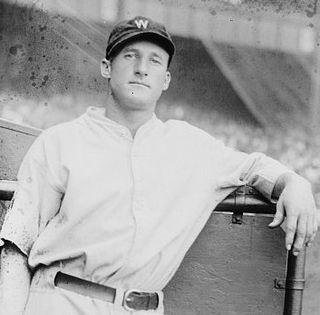
Leon Allen "Goose" Goslin was an American professional baseball left fielder. He played in Major League Baseball for the Washington Senators, St. Louis Browns, and Detroit Tigers, from 1921 until 1938.

Abram Harding "Hardy" Richardson, also known as "Hardie" and "Old True Blue", was an American professional baseball player whose career spanned from 1875 to 1892 with a brief minor league comeback in 1898. He played 14 seasons in Major League Baseball, playing at every position, including 585 games at second base, 544 games in the outfield, and 178 games at third base. Richardson played for six major league teams, with his longest stretches having been for the Buffalo Bisons (1879–1885), Detroit Wolverines (1886–1888) and Boston Reds (1890–91).

Lafayette Napoleon Cross was an American professional baseball player. He played in Major League Baseball as a third baseman from 1887 to 1907. Cross played most of his 21-year career with Philadelphia-based teams in four different leagues. One of the sport's top all-around players in the years surrounding the turn of the 20th century, when he retired he ranked fifth in major league history in hits (2,644) and runs batted in (1,371), ninth in doubles (411) and total bases (3,466), and third in games played (2,275) and at bats (9,064).

Thomas David Henrich, nicknamed "the Clutch" and "Old Reliable", was an American professional baseball player of German descent. He played his entire Major League Baseball career as a right fielder and first baseman for the New York Yankees. Henrich led the American League in triples twice and in runs scored once, also hitting 20 or more home runs four times. He is best remembered for his numerous exploits in the World Series; he was involved in one of the most memorable plays in Series history in 1941, was the hitting star of the 1947 Series with a .323 batting average, and hit the first walk-off home run in Series history in the first game of the 1949 World Series.
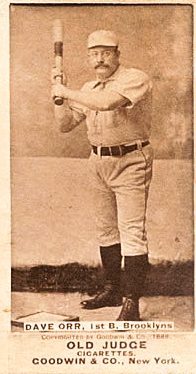
David L. Orr was a first baseman in Major League Baseball from 1883 through 1890. Orr played most of his career in the American Association for the New York Metropolitans (1883–1887), Brooklyn Bridegrooms (1888) and Columbus Solons (1889). He also played for the New York Gothams in the National League for one game in 1883 and for the Brooklyn Ward's Wonders of the Players' League in 1890.
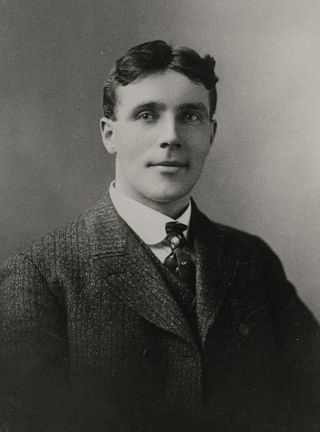
James Edward "Tip" O'Neill was a Canadian professional baseball player from approximately 1875 to 1892. He began playing organized baseball in Woodstock, Ontario, Canada, and later played ten seasons in Major League Baseball, principally as a left fielder, but also as a pitcher, for four major league clubs.

Paul Aloysius Hines was an American center fielder in professional baseball who played in the National Association and Major League Baseball from 1872 to 1891. Born in Virginia, he is credited with winning baseball's first batting triple crown in 1878 ; the accomplishment was not noted at the time, as runs batted in would not be counted until years later, home runs were rare and home run leadership obscure, and Abner Dalrymple was then erroneously recognized as the batting champion. Hines was the first of only three players to achieve the batting Triple Crown in the 19th century.

Arthur Frederick "Solly" Hofman was an American Major League Baseball player from 1903 to 1916. He played the majority of his 1,194 games in the outfield.

Joseph Daniel Votto is a Canadian professional baseball first baseman for the Cincinnati Reds of Major League Baseball (MLB). He made his MLB debut with the Reds in 2007. He is the first Canadian MLB player since Larry Walker to hit 300 home runs and have 1,000 career runs batted in (RBI). Votto is also the second Canadian to have 2,000 hits, the first also being Walker.

Walter Tyrone Woods (born August 16, 1969 is a former professional baseball player. He played five seasons with the Korea Baseball Organization then six further seasons in Nippon Professional Baseball, primarily as a first baseman.
Wins Above Replacement or Wins Above Replacement Player, commonly abbreviated to WAR or WARP, is a non-standardized sabermetric baseball statistic developed to sum up "a player's total contributions to his team". A player's WAR value is claimed to be the number of additional wins his team has achieved above the number of expected team wins if that player were substituted with a replacement-level player: a player who may be added to the team for minimal cost and effort.
Joseph Louis Tuminelli was an American professional baseball third baseman in Minor League Baseball. Listed at 5 feet 9 inches (1.75 m) and 165 pounds (75 kg), he batted and threw right-handed.
References
- ↑ Dickson, Paul (2009). The Dickson Baseball Dictionary (Third ed.). W. W. Norton. p. 883. ISBN 978-0-393-06681-4.